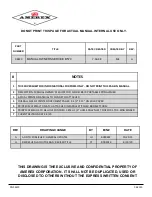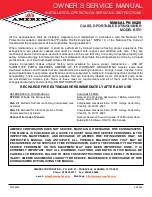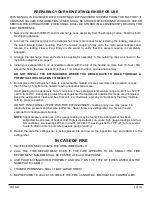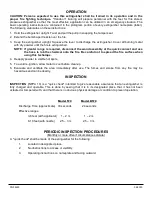
PN 08220
04/2020
10.
Inspect the valve body for signs of corrosion or damage to the hose
-
thread connection. Replace valve
assembly as necessary following the depressurizing and recharge procedures. If valve removal is
required, complete all steps in the "
Recharge Procedure
".
11.
Reconnect the extension applicator to the discharge hose male swivel coupling. Rotate the hose
assembly several times to verify that the swivel operates freely (disconnect again and clean the inside of
the female swivel with a small brush and compressed air if the rotation is impeded). Arrange the hose and
extension applicator assembly according to the installation instructions on page 9.
12.
Install new tamper seal, and record service data on the extinguisher inspection tag.
13.
Return to its proper location. Install on/in wall hanger bracket, vehicle bracket, or dolly cart making sure
that it fits properly. Replace mounting bracket if necessary.
RECHARGE
Recharging (NFPA 10) is the replacement of the extinguishing agent and also includes the expellant for this
type of extinguisher.
WARNING:
1.
Before attempting to recharge, be sure the extinguisher is completely depressurized.
2.
Never have any part of your body over the extinguisher while removing the valve assembly.
3.
Use a protective shield between you and the pressure gauge while charging an extinguisher. Do not stand
in front of the gauge if a shield is not available.
4.
Use a regulated pressurizing source of ARGON ONLY. Set the regulator to no more than 220 psi (1520
kPa).
5.
Check and calibrate regulator gauge at frequent intervals. The regulator gauge shall be used to determine
when the intended charging pressure has been reached. Do not use the extinguisher gauge for this
purpose.
6.
Never leave an extinguisher connected to a regulator of a high
-
pressure source for an extended period of
time. A defective regulator could cause the cylinder to rupture due to excessive pressure.
7. Do not mix types of chemicals in extinguishers, recharge, or recovery systems. Mixing ABC, Regular, or
Purple K dry chemicals with a dry powder agent could cause a serious flare up or explosion if the dry
chemical were to contact a combustible metal fire.
RECHARGE PROCEDURE
1.
Perform steps 1 through 4 of the "
Complete Maintenance (Six
-
Year Teardown)
" section including those
required in the "
Maintenance Procedure
."
2.
Thoroughly clean all parts with a soft bristle brush or soft cloth. Blow the valve and downtube out with air
or argon. Disassemble valve assembly by removing the downtube, spring, and valve stem assembly.
Remove the collar O
-
ring form the valve assembly. Replace the collar O
-
ring and valve stem with new
parts. Inspect the spring and downtube assembly –
replace parts if worn or damaged. Lubricate the collar
O
-
ring on the valve stem with V
-
711.
DO NOT LUBRICATE THE VALVE STEM SEAL
.
3.
Reassemble the valve assembly, including downtube, and set aside.
4.
Remove any dry powder remaining in the cylinder. Properly dispose of any dry powder that is
contaminated or caked.









